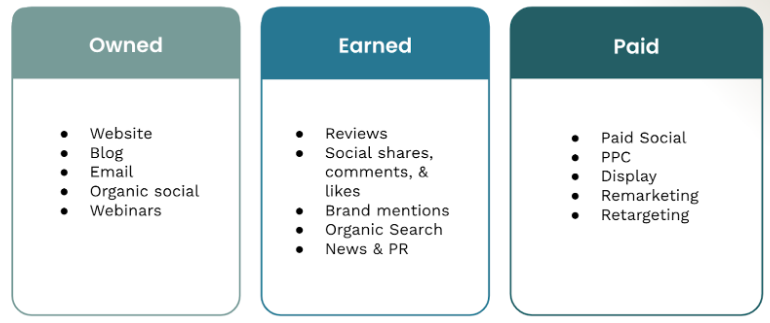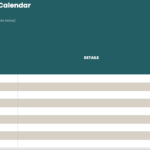Your content team has been hard at work — researching, briefing, and developing helpful, engaging content. You’ve posted it to your website, and now you wait. Right?
Not quite.
Your content should be attracting organic traffic via search, but why rely on search engines alone to get eyes on the fruits of your labor? That’s where content distribution comes in.
What is content distribution?
Content distribution is the act of publishing, sharing, and promoting content in different formats across multiple channels.
Distributing your content helps improve your brand’s visibility, drive traffic to your site, and engage and delight your users — new and returning.
What is a content distribution strategy?
Content distribution requires forethought, planning, and commitment. Your content distribution strategy is your plan: which content will you distribute? Where? When? And how often?
A content distribution strategy ensures your team is consistently sharing your content with your audience, wherever they may be — more on that later.
Why is a content distribution strategy important?
These days, everyone and their uncle are jumping on the content bandwagon — and that’s super cool! We love to see marketers embrace the power of good content. But how can your business cut through the noise?
Sharing the right content on the right channels will help position you as a thought leader in your space. And, as we mentioned, it gets more eyes on your content.
What’s more, content distribution allows you to set strategic goals to track and measure the performance of your content.
How do you develop an effective content distribution strategy?
There are eight important steps to take when crafting your content distribution strategy:
- Set goals
- Know your audience
- Choose the right channels
- Share the right content
- Use the right tools
- Create a content distribution calendar
- Create and distribute your content
- Measure your performance
Let’s break it down.
1. Set goals
Content can support prospects in multiple stages of the buying funnel. But without mapping out your goals, objectives, strategies, and tactics, you won’t know whether you’re succeeding in attracting, engaging, and delighting.
You’ll want to get granular with this — determine the metrics you’ll use to measure success at each stage:
Stage: Awareness
Traffic: How many people are visiting your content?
- Users – the number of unique visitors to your page
- Pageviews – the number of times a page has been viewed
- Unique pageviews — the aggregate number of pageviews generated by the same user in a given session
Traffic Sources and Mediums: Where is your site traffic coming from?
Organic Search Performance: Think impressions, clicks, click-through rate (CTR), and average position
Stage: Consideration
Engagement: Look at time spent on page, average session duration, pages per session, scroll depth, and bounce rate
Micro Conversions: Micro conversions may be newsletter subscribes, RFIs, etc.
Social Sentiment: Consider social shares, comments, likes, follows, and mentions
Stage: Decision
Email: Look at open rate, CTR, downloads, and subscriber churn
Goal Completions or Macro Conversions: Are people purchasing or booking with you after reading your content?
2. Know your audience
In order to serve content to your target audience, you need to determine who your target audience is. Use Google Analytics, social analytics, and customer surveys and interviews to gather information on your audience’s demographics, online behavior, pain points, and needs. Gathering this data will have a tremendous impact on your content distribution strategy.
If you don’t have them already, develop buyer personas. When you have them well-defined, you can move on to the next step.

3. Choose the right channels
Meet your audience where they are. If your target buyer is on Facebook, don’t waste your time sharing content on LinkedIn (where users are not typically looking to make purchases anyway).
With that being said, make sure your content is appropriate for the channels you choose. Your blog post may be fantastic, but is it appropriate to share it on Instagram? Probably not. Instead, opt for a more visual version of the content. Infographics, for example, lead to higher engagement, information retention, and more.
Also consider whether you’ll use owned, earned, or paid channels (we recommend all three!).

Owned media
Owned channels are, well, what you own — your website and blog, social media profiles, email/newsletter, etc.
Tip: Always pay close attention to your owned assets. If you’re driving traffic to your website from earned and paid tactics, ensure that you have a strong foundation that demonstrates Experience, Expertise, Authority, and Trust, or E-E-A-T.
Earned media
Earned media is, in essence, word-of-mouth advertising. It takes the form of reviews, social shares, PR, and even forums.
Tip: The key to earned media is relationships. Be responsive on social media and reviews, network with other industry experts who will appreciate your content, etc.
Paid media
Another self-explanatory channel: paid media is what you pay to advertise. Think PPC, paid social, and display.
Tip: Use paid channels to distribute your highest quality and highest priority content.
4. Share the right content
Not all content is good content. The “right” content is content that:
- Gets your message across (who are you and what is your unique value proposition?)
- Reaches your audience where they are with what they need to help address their needs and pain points
- Is in the best format for the audience you’re targeting and the platform you’re distributing it on
Tip: Keep in mind that certain demographics prefer different content types. Millennials, for example, have a strong preference for videos.
Content types you can share include:
- Blogs
- Videos
- Infographics
- Case studies
- Testimonials
- Webinars
- White papers
- Podcasts
Keep in mind that one piece of content can be the genesis for multiple formats of content. Making an effort to repurpose what you already have can expand the reach of your content and slash the amount of time and money you need to spend on content creation (since you’re not having to come up with new ideas 24/7).
The complexity of pulling this off — generating little content bits from bigger content pieces — is a major benefit of mapping it all out in your content distribution strategy.
5. Use the right tools
Content distribution tools can help make your and your team’s lives easier. Here are some of our favorites:
- CoSchedule: The Marketing Calendar product helps you see, schedule, and share your marketing in one place.
- Buffer: Plan and publish your content for Instagram, TikTok, Facebook, Twitter, Pinterest, and LinkedIn, all from one simple dashboard.
- Connectively: Connectively connects journalists and bloggers with relevant expert sources. You (and your content) could be an expert source.
- MailChimp: Grow your revenue with targeted and engaging emails that get more customers to open, click, and buy.
Most of the listed tools have free account options, but you’ll get more features if you pay for a membership.
6. Create a content distribution calendar
If you don’t have one already, now is the time to create a content distribution calendar.
Different teams may have their own content creation calendars, but having one specifically for scheduling distribution — that all essential team members can see and contribute to — is the key to staying on top of your content distribution goals.
You can create your content distribution calendar in Excel or Google Sheets, Google Calendar, or one of the tools we discussed above, such as CoSchedule.
We’ve created two different Google Sheets templates for you to use — you can get both of them for free!

Templates: Content Distribution Calendars
It can be difficult to know where to start with content distribution, but beginning with a solid template is the perfect way to set the wheels in motion. Make a copy of the Google Sheet and get started today.
7. Create and distribute your content!
It’s showtime! All the pieces are now in place for you to start creating content and distributing it like crazy.
Make sure your content creation is guided by an audience-driven SEO strategy — otherwise, you’re just flinging content at the wall to see what sticks.
8. Measure your performance
Since you set SMART goals, you’ll want to pay close attention to how well you’re attaining them.
Using Analytics, Search Console, and individual social and email platform analytics, you’ll be able to track and report on your content distribution performance.
Tip: Elevate your reporting by connecting your Analytics with Looker Studio (formerly Data Studio).
We have an entire playlist of GA4 tutorials that can help you learn how to track and report on your KPIs — if you haven’t yet made the switch to GA4, please do. The sooner you start to get comfortable in the new interface, the less catastrophic the sunsetting of Universal Analytics will be for your team.
Effective content distribution starts with great content
So there you have it! Eight steps to an effective content distribution strategy. Of course, content distribution won’t do you any good if you don’t have top-tier content. Need help with your content marketing strategy? Two Octobers is here for you. We offer content marketing services in addition to training for your team.




